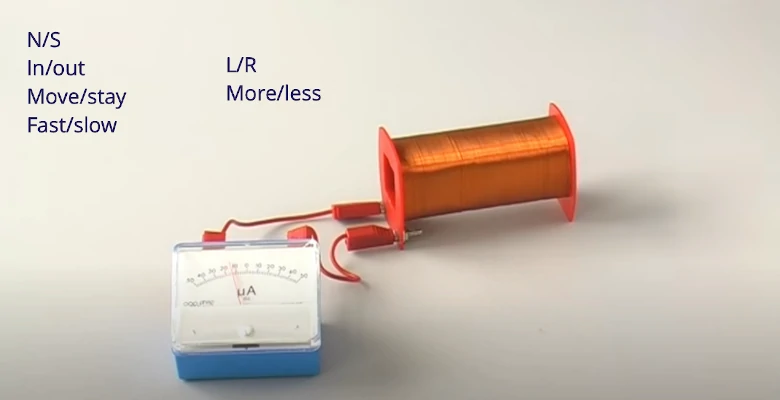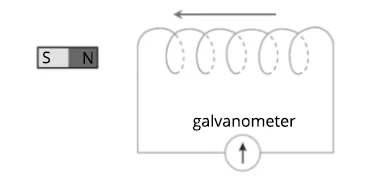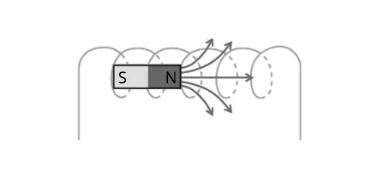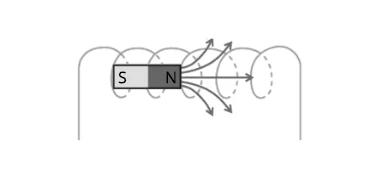Electromagnetic Induction
In this article we will learn about the Laws and Principles of Electromagnetic Induction and will cover the following sub-topics:
- Deduce that an e.m.f. can be induced by a changing magnetic field
- State that the direction of the induced e.m.f. opposes the change producing it
- List the factors that affect the magnitude of the induced e.m.f.
Faraday’s Solenoid Experiment

Image Credit: youtube - ibphysicshelp
The image you see above is the setup of Faraday’s solenoid experiment, which was conducted by Faraday in the year 1831.
The setup contains a solenoid coil, which is essentially conductor wire wrapped around a non-conducting material, an ammeter, and a magnet.
We observe that when a magnet is inserted into the solenoid, there is a deflection in the ammeter.
The deflection changes directions when the pole of the magnet is changed in the direction of the coil. We observe that when the magnet is moved faster through the solenoid, a larger deflection is seen whereas a slower movement results in smaller deflection.
Further, when a magnet is kept stationary in the solenoid, there is no deflection in the ammeter being observed.
As we note these observations, let us try and understand why these results are so significant.
Observations
- What happens to the deflection of the ammeter's pointer when the N pole of the magnet
- is inserted into the solenoid; Left
- stays in the solenoid; None
- is withdrawn from the solenoid. Right
- What happens to the deflection of the ammeter's pointer when the S pole of the magnet
- is inserted into the solenoid; Right
- stays in the solenoid; None
- is withdrawn from the solenoid. Left
What do we understand from the experiment?
These are the conclusions after repeated trials and observations:
- When a magnet is being inserted into a solenoid, the galvanometer needle is deflected in one direction.
- When the magnet is stationary in the solenoid, the galvanometer needle is not deflected in any direction.
- When the magnet is being withdrawn from the same solenoid, the galvanometer needle is deflected in the other direction.
Concept Check
The magnet is held stationary while the solenoid moves towards the magnet.
Question 1:
Will there be deflection observed in the galvanometer?

- Yes
- No
Solution:
Option A
Explanation:
A deflection will be observed in the galvanometer due to the relative motion between the magnet and the solenoid. As a result of the relative motion, a current is generated across the solenoid and a deflection is observed across the galvanometer.
Question 2:
When the magnet is being inserted into the solenoid as shown, there is an increase in magnetic flux linkage with the coils.

Is the above statement true or false?
- True
- False
Solution:
Option A
Explanation:
There will be an increase in the number of magnetic field lines cutting across the solenoid and hence there will be an increase in magnetic flux linkage with the coils.
Conclusion & Explanations
| Conclusions | Explanation |
|---|---|
|
|
|
|
|
|
Question 3:
When the magnet stays within the solenoid, the magnetic flux linkage with the coils is still changing.

Is the above statement true or false?
- True
- False
Solution:
Option B
Explanation:
As there is no change in relative motion between magnet and the solenoid hence, there is no change in flux linkage.
Theory based on Faraday’s Solenoid Experiment
Faraday’s Solenoid Experiment
It is the change in magnetic flux linkage between the magnetic field and the coils that induces an e.m.f. (& current) in the circuit that causes the deflection observed.
Question 4:
Based on this significant discovery and conclusion below, it is reasonable to infer that the rate of change of magnetic flux linking the coils directly determines the magnitude of the induced e.m.f. in the circuit.
Is the above statement true or false?
- True
- False
Solution:
Option A
Explanation:
It is the change in magnetic flux linkage between the magnetic field and the coils that induces an E.M.F (& current) in the circuit that causes the deflection observed.
The rate of change of magnetic flux linking the coil directly determines the magnitude of the induced e.m.f. in the circuit. The faster the magnetic flux linkage changes the greater is the magnitude of the deflection observed.
Question 5:
What happens to the deflection of the ammeter's pointer when the speed at which the magnet is inserted/withdrawn is:
- increased -> Deflects more/ less
- decreased -> Deflects more/ less
Solution:
- Deflects more
- Deflects less
Explanation:
As previously explained, when the rate of magnetic flux linkage increases it results in a higher magnitude of current to flow through the solenoid and hence, the galvanometer shows higher deflection when the speed of the magnet is increased and it decreases when the speed of the magnet decreases.
Faraday’s Law of Electromagnetic Induction
The magnitude of the induced e.m.f. in a circuit is directly proportional to the rate of change of magnetic flux linking the coils.
Question 6:
Which of the following will not affect the rate of change of magnetic flux linkage between the magnetic field and the solenoid?
- Increasing the strength of the magnet.
- Decreasing the number of turns in the solenoid.
- Changing the speed of relative motion between the magnet and the solenoid.
- Reversing the direction of motion between the magnet and the solenoid while moving at constant speed.
Solution:
Option D
Explanation:
Upon reversing the direction of motion between the magnet and the solenoid while moving at constant speed, there is no change in the flux linked with the coil and hence as a result it will not affect the rate of change of magnetic flux between magnetic field and solenoid.
Question 7:
Which of the following will not affect the magnitude of the induced e.m.f in the circuit?
- Increasing the strength of the magnet.
- Decreasing the number of turns in the solenoid.
- Changing the speed of relative motion between the magnet and the solenoid.
- Reversing the direction of motion between the magnet and the solenoid while moving at constant speed.
Solution:
Option D
Explanation:
Upon reversing the direction of motion between the magnet and the solenoid while moving at constant speed, there is no change in the flux linked with the coil and hence as a result it will not affect the magnitude of the induced e.m.f in the circuit, as per Faraday’s Law of Electromagnetic Induction.
Conclusion
In this article, we learned about Electromagnetic Induction Laws. We looked at how to deduce that an e.m.f. can be induced by a changing magnetic field. We also observed and listed the different factors that change the magnitude of the induced e.m.f.
| Continue Learning | |
|---|---|
| Electromagnetic Spectrum | Sound |
| Static Electricity | D.C. Circuits |
| Electromagnetic Induction | Electromagnetism |
| Magnetism | Current Electricity |
| Practical Electricity | |


 SG
SG  VN
VN 















